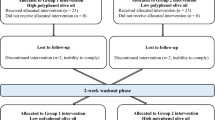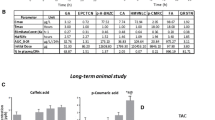Abstract
Aim
Phenolic compounds naturally contained in extra-virgin olive oil (EVOO) have demonstrated anti-inflammatory and antioxidant properties. The present study aimed at evaluating the effects of a polyphenol-rich extra-virgin olive oil (EVOO) (high-polyphenol EVOO, HP-EVOO) on the metabolic control and the production of specific pro-/anti-inflammatory adipokines in overweight patients with type 2 diabetes mellitus (T2D).
Methods
Eleven overweight T2D patients not in treatment with insulin were invited to follow their habitual diet for a total of 8 weeks. During the first 4 weeks (wash-out period), they were asked to consume refined olive oil (ROO, polyphenols not detectable) and then to replace ROO with HP-EVOO (25 mL/day, 577 mg of phenolic compounds/kg) for the remaining 4 weeks. Anthropometric parameters, fasting glycaemia, glycated haemoglobin (HbA1c), high-sensitive C-reactive protein, plasma lipid profile, liver function and serum levels of TNF-α, IL-6, adiponectin, visfatin and apelin were assessed at the end of each 4-week period.
Results
HP-EVOO consumption significantly reduced fasting plasma glucose (P = 0.023) and HbA1c (P = 0.039) levels as well as BMI (P = 0.012) and body weight (P = 0.012). HP-EVOO ingestion determined a reduction in serum level of aspartate aminotransferase (AST, P = 0.0056) and alanine aminotransferase (ALT, P = 0.024). Serum visfatin levels strongly decreased after HP-EVOO ingestion (P = 0.0021).
Conclusions
Daily consumption of polyphenol-rich EVOO might improve metabolic control and circulating inflammatory adipokines profile in overweight T2D patients.
Similar content being viewed by others
References
Tuomilehto J, Lindstrom J, Eriksson JG et al (2001) Prevention of type 2 diabetes mellitus by changes in lifestyle among subjects with impaired glucose tolerance. N Engl J Med 344:1343–1350. doi:10.1056/NEJM200105033441801
Khazrai YM, Defeudis G, Pozzilli P (2014) Effect of diet on type 2 diabetes mellitus: a review. Diabetes Metab Res Rev 30(Suppl 1):24–33. doi:10.1002/dmrr.2515
Hirai S, Takahashi N, Goto T, Lin S, Uemura T, Yu R, Kawada T (2010) Functional food targeting the regulation of obesity-induced inflammatory responses and pathologies. Mediat Inflamm 2010:367838. doi:10.1155/2010/367838
Bluher M (2014) Adipokines–removing road blocks to obesity and diabetes therapy. Mol Metab 3:230–240. doi:10.1016/j.molmet.2014.01.005
Chang YH, Chang DM, Lin KC, Shin SJ, Lee YJ (2011) Visfatin in overweight/obesity, type 2 diabetes mellitus, insulin resistance, metabolic syndrome and cardiovascular diseases: a meta-analysis and systemic review. Diabetes Metab Res Rev 27:515–527. doi:10.1002/dmrr.1201
Bertrand C, Valet P, Castan-Laurell I (2015) Apelin and energy metabolism. Front Physiol 6:115. doi:10.3389/fphys.2015.00115
Georgoulis M, Kontogianni MD, Yiannakouris N (2014) Mediterranean diet and diabetes: prevention and treatment. Nutrients 6:1406–1423. doi:10.3390/nu6041406
Salas-Salvado J, Bullo M, Estruch R et al (2014) Prevention of diabetes with Mediterranean diets: a subgroup analysis of a randomized trial. Ann Intern Med 160:1–10. doi:10.7326/M13-1725
Covas MI, de la Torre R, Fito M (2015) Virgin olive oil: a key food for cardiovascular risk protection. Br J Nutr 113(Suppl 2):S19–S28. doi:10.1017/S0007114515000136
Cicerale S, Lucas L, Keast R (2010) Biological activities of phenolic compounds present in virgin olive oil. Int J Mol Sci 11:458–479. doi:10.3390/ijms11020458
Martin-Pelaez S, Covas MI, Fito M, Kusar A, Pravst I (2013) Health effects of olive oil polyphenols: recent advances and possibilities for the use of health claims. Mol Nutr Food Res 57:760–771. doi:10.1002/mnfr.201200421
Cicerale S, Lucas LJ, Keast RS (2012) Antimicrobial, antioxidant and anti-inflammatory phenolic activities in extra virgin olive oil. Curr Opin Biotechnol 23:129–135. doi:10.1016/j.copbio.2011.09.006
Santangelo C, Vari R, Scazzocchio B, Filesi C, Masella R (2014) Management of reproduction and pregnancy complications in maternal obesity: which role for dietary polyphenols? BioFactors 40:79–102. doi:10.1002/biof.1126
Gimeno E, Castellote AI, Lamuela-Raventos RM, de la Torre-Boronat MC, Lopez-Sabater MC (2001) Rapid high-performance liquid chromatographic method for the simultaneous determination of retinol, alpha-tocopherol and beta-carotene in human plasma and low-density lipoproteins. J Chromatogr B Biomed Sci Appl 758:315–322
Cavina G, Gallinella B, Porra R, Pecora P, Suraci C (1988) Carotenoids, retinoids and alpha-tocopherol in human serum: identification and determination by reversed-phase HPLC. J Pharm Biomed Anal 6:259–269
Owen RW, Giacosa A, Hull WE, Haubner R, Wurtele G, Spiegelhalder B, Bartsch H (2000) Olive-oil consumption and health: the possible role of antioxidants. Lancet Oncol 1:107–112
Suarez M, Valls RM, Romero MP, Macia A, Fernandez S, Giralt M, Sola R, Motilva MJ (2011) Bioavailability of phenols from a phenol-enriched olive oil. Br J Nutr 106:1691–1701. doi:10.1017/S0007114511002200
Itsiopoulos C, Brazionis L, Kaimakamis M, Cameron M, Best JD, O’Dea K, Rowley K (2011) Can the Mediterranean diet lower HbA1c in type 2 diabetes? Results from a randomized cross-over study. Nutr Metab Cardiovasc Dis 21:740–747. doi:10.1016/j.numecd.2010.03.005
Konstantinidou V, Covas MI, Munoz-Aguayo D et al (2010) In vivo nutrigenomic effects of virgin olive oil polyphenols within the frame of the Mediterranean diet: a randomized controlled trial. FASEB J 24:2546–2557. doi:10.1096/fj.09-148452
Guasch-Ferre M, Hruby A, Salas-Salvado J, Martinez-Gonzalez MA, Sun Q, Willett WC, Hu FB (2015) Olive oil consumption and risk of type 2 diabetes in US women. Am J Clin Nutr 102:479–486. doi:10.3945/ajcn.115.112029
Esposito K, Giugliano D (2014) Mediterranean diet and type 2 diabetes. Diabetes Metab Res Rev 30(Suppl 1):34–40. doi:10.1002/dmrr.2516
Khaw KT, Wareham N, Luben R, Bingham S, Oakes S, Welch A, Day N (2001) Glycated haemoglobin, diabetes, and mortality in men in Norfolk cohort of european prospective investigation of cancer and nutrition (EPIC-Norfolk). BMJ 322:15–18
Esposito K, Maiorino MI, Di Palo C, Giugliano D, Campanian Postprandial Hyperglycemia Study G (2009) Adherence to a Mediterranean diet and glycaemic control in type 2 diabetes mellitus. Diabet Med 26:900–907. doi:10.1111/j.1464-5491.2009.02798.x
Petelin A, Bizjak M, Cernelic-Bizjak M, Jurdana M, Jakus T, Jenko-Praznikar Z (2014) Low-grade inflammation in overweight and obese adults is affected by weight loss program. J Endocrinol Investig 37:745–755. doi:10.1007/s40618-014-0102-9
Schroder H, Marrugat J, Vila J, Covas MI, Elosua R (2004) Adherence to the traditional mediterranean diet is inversely associated with body mass index and obesity in a spanish population. J Nutr 134:3355–3361
Marrugat J, Covas MI, Fito M et al (2004) Effects of differing phenolic content in dietary olive oils on lipids and LDL oxidation: a randomized controlled trial. Eur J Nutr 43:140–147. doi:10.1007/s00394-004-0452-8
Masella R, Giovannini C, Vari R, Di Benedetto R, Coni E, Volpe R, Fraone N, Bucci A (2001) Effects of dietary virgin olive oil phenols on low density lipoprotein oxidation in hyperlipidemic patients. Lipids 36:1195–1202
Gimeno E, Fito M, Lamuela-Raventos RM, Castellote AI, Covas M, Farre M, de La Torre-Boronat MC, Lopez-Sabater MC (2002) Effect of ingestion of virgin olive oil on human low-density lipoprotein composition. Eur J Clin Nutr 56:114–120. doi:10.1038/sj.ejcn.1601293
Farrell N, Norris G, Lee SG, Chun OK, Blesso CN (2015) Anthocyanin-rich black elderberry extract improves markers of HDL function and reduces aortic cholesterol in hyperlipidemic mice. Food Funct 6:1278–1287. doi:10.1039/c4fo01036a
Ali F, Jamil H, Anwar SS, Wajid N (2015) Characterization of lipid parameters in diabetic and non-diabetic atherosclerotic patients. J Geriatr Cardiol JGC 12:37–43. doi:10.11909/j.issn.1671-5411.2015.01.005
Ho CI, Chen JY, Chen SY, Tsai YW, Weng YM, Tsao YC, Li WC (2015) Relationship between TG/HDL-C ratio and metabolic syndrome risk factors with chronic kidney disease in healthy adult population. Clin Nutr 34:874–880. doi:10.1016/j.clnu.2014.09.007
Fito M, Cladellas M, de la Torre R et al (2008) Anti-inflammatory effect of virgin olive oil in stable coronary disease patients: a randomized, crossover, controlled trial. Eur J Clin Nutr 62:570–574. doi:10.1038/sj.ejcn.1602724
Urpi-Sarda M, Casas R, Chiva-Blanch G et al (2012) Virgin olive oil and nuts as key foods of the Mediterranean diet effects on inflammatory biomakers related to atherosclerosis. Pharmacol Res 65:577–583. doi:10.1016/j.phrs.2012.03.006
Chang YC, Chang TJ, Lee WJ, Chuang LM (2010) The relationship of visfatin/pre-B-cell colony-enhancing factor/nicotinamide phosphoribosyltransferase in adipose tissue with inflammation, insulin resistance, and plasma lipids. Metabolism 59:93–99. doi:10.1016/j.metabol.2009.07.011
Chen MP, Chung FM, Chang DM, Tsai JC, Huang HF, Shin SJ, Lee YJ (2006) Elevated plasma level of visfatin/pre-B cell colony-enhancing factor in patients with type 2 diabetes mellitus. J Clin Endocrinol Metab 91:295–299. doi:10.1210/jc.2005-1475
Filippatos TD, Derdemezis CS, Kiortsis DN, Tselepis AD, Elisaf MS (2007) Increased plasma levels of visfatin/pre-B cell colony-enhancing factor in obese and overweight patients with metabolic syndrome. J Endocrinol Invest 30:323–326
Shaker O, El-Shehaby A, Zakaria A, Mostafa N, Talaat S, Katsiki N, Mikhailidis DP (2011) Plasma visfatin and retinol binding protein-4 levels in patients with type 2 diabetes mellitus and their relationship to adiposity and fatty liver. Clin Biochem 44:1457–1463. doi:10.1016/j.clinbiochem.2011.08.1148
Dray C, Knauf C, Daviaud D et al (2008) Apelin stimulates glucose utilization in normal and obese insulin-resistant mice. Cell Metab 8:437–445. doi:10.1016/j.cmet.2008.10.003
Cheng X, Cheng XS, Pang CC (2003) Venous dilator effect of apelin, an endogenous peptide ligand for the orphan APJ receptor, in conscious rats. Eur J Pharmacol 470:171–175
Habchi M, Duvillard L, Cottet V et al (2014) Circulating apelin is increased in patients with type 1 or type 2 diabetes and is associated with better glycaemic control. Clin Endocrinol (Oxf) 81:696–701. doi:10.1111/cen.12404
Kadoglou NP, Sailer N, Kapelouzou A, Lampropoulos S, Vitta I, Kostakis A, Liapis CD (2012) Effects of atorvastatin on apelin, visfatin (nampt), ghrelin and early carotid atherosclerosis in patients with type 2 diabetes. Acta Diabetol 49:269–276. doi:10.1007/s00592-011-0310-0
Villegas R, Xiang YB, Elasy T et al (2011) Liver enzymes, type 2 diabetes, and metabolic syndrome in middle-aged, urban Chinese men. Metab Syndr Relat Disord 9:305–311. doi:10.1089/met.2011.0016
Kunutsor SK, Apekey TA, Walley J (2013) Liver aminotransferases and risk of incident type 2 diabetes: a systematic review and meta-analysis. Am J Epidemiol 178:159–171. doi:10.1093/aje/kws469
Assy N, Nassar F, Nasser G, Grosovski M (2009) Olive oil consumption and non-alcoholic fatty liver disease. World J Gastroenterol 15:1809–1815
Fraser A, Abel R, Lawlor DA, Fraser D, Elhayany A (2008) A modified Mediterranean diet is associated with the greatest reduction in alanine aminotransferase levels in obese type 2 diabetes patients: results of a quasi-randomised controlled trial. Diabetologia 51:1616–1622. doi:10.1007/s00125-008-1049-1
Storniolo CE, Casillas R, Bullo M et al (2015) A Mediterranean diet supplemented with extra virgin olive oil or nuts improves endothelial markers involved in blood pressure control in hypertensive women. Eur J Nutr. doi:10.1007/s00394-015-1060-5
Author information
Authors and Affiliations
Corresponding author
Ethics declarations
Conflict of interest
The authors declare that they have no conflict of interest.
Ethical approval
All procedures performed in studies involving humans were in accordance with the ethical standards of the institution or practice at which the studies were conducted, and with the 1964 Helsinki Declaration and its later amendments or comparable ethical standards.
Informed consent
Informed consent was obtained from all individual participants included in the study.
Rights and permissions
About this article
Cite this article
Santangelo, C., Filesi, C., Varì, R. et al. Consumption of extra-virgin olive oil rich in phenolic compounds improves metabolic control in patients with type 2 diabetes mellitus: a possible involvement of reduced levels of circulating visfatin. J Endocrinol Invest 39, 1295–1301 (2016). https://doi.org/10.1007/s40618-016-0506-9
Received:
Accepted:
Published:
Issue Date:
DOI: https://doi.org/10.1007/s40618-016-0506-9




